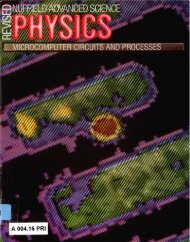RISC vs. CISC
RISC vs. CISC
RISC vs. CISC
You also want an ePaper? Increase the reach of your titles
YUMPU automatically turns print PDFs into web optimized ePapers that Google loves.
CECS 440 Computer Architecture © 1999 R. W. Allison<br />
C. Compilers<br />
David Patterson, in a recently published retrospective article on his original proposal paper for the <strong>RISC</strong> I<br />
project at Berkeley, writes:<br />
‘Something to keep in mind while reading the paper was how lousy the compilers were of that<br />
generation. C programmers had to write the word "register" next to variables to try to get<br />
compilers to use registers. As a former Berkeley Ph.D. who started a small computer company<br />
said later, "people would accept any piece of junk you gave them, as long as the code worked."<br />
Part of the reason was simply the speed of processors and the size of memory, as programmers<br />
had limited patience on how long they were willing to wait for compilers.’ [3]<br />
The compiler’s job was fairly simple at that point: translate statements written in a high level language (HLL),<br />
like C or PASCAL, into assembly language. The assembly language was then converted into machine code by<br />
an assembler. The compilation stage took a long time, and the output was hardly optimal. As long as the HLL to<br />
assembly translation was correct, that was about the best you could hope for. If you really wanted compact,<br />
optimized code, your only choice was to code in assembler. (In fact, some would argue that this is still the case<br />
today.)<br />
D. VLSI<br />
The state of the art in Very Large Scale Integration (VLSI) yielded transistor densities that were low by today’s<br />
standards. You just couldn’t fit too much functionality onto one chip. Back in 1981 when Patterson and Sequin<br />
first proposed the <strong>RISC</strong> I project (<strong>RISC</strong> I later became the foundation for Sun’s SPARC architecture), a million<br />
transistors on a single chip was a lot [1]. Because of the scarcity of available transistor resources, the <strong>CISC</strong><br />
machines of the day, like the VAX, had their various functional units split up across multiple chips. This was a<br />
problem, because the delay-power penalty on data transfers between chips limited performance. A single-chip<br />
implementation would have been ideal, but, for reasons we’ll get into in a moment, it wasn’t feasible without a<br />
radical rethinking of current designs.<br />
II. The <strong>CISC</strong> solution<br />
A. The HLLCA and the software crisis<br />
Both the sorry state of early compilers and the memory-induced constraints on code size caused some<br />
researchers in the late 60’s and early 70’s to predict a coming "software crisis." Hardware was getting cheaper,<br />
they argued, while software costs were spiraling out of control. A number of these researchers insisted that the<br />
only way to stave off impending doom was to shift the burden of complexity from the (increasingly expensive)<br />
software level to the (increasingly inexpensive) hardware level. If there was a common function or operation for<br />
which a programmer had to write out all the steps every time he or she used it, why not just implement that<br />
function in hardware and make everyone’s life easier? After all, hardware was cheap (relatively speaking) and<br />
programmer time wasn’t. This idea of moving complexity from the software realm to the hardware realm is the<br />
driving idea behind <strong>CISC</strong>, and almost everything that a true <strong>CISC</strong> machine does is aimed at this end.<br />
Some researchers suggested that the way to make programmers and compiler-writers jobs easier was to "close<br />
the semantic gap" between statements in a high-level language and the corresponding statements in assembler.<br />
"Closing the semantic gap" was a fancy way of saying that system designers should make assembly code look<br />
more like C or PASCAL code. The most extreme proponents of this kind of thinking were calling for the move<br />
to a High-Level Language Computing Architecture (HLLCA).<br />
<strong>RISC</strong> <strong>vs</strong>. <strong>CISC</strong>: The Post-<strong>RISC</strong> Era – Page 3











